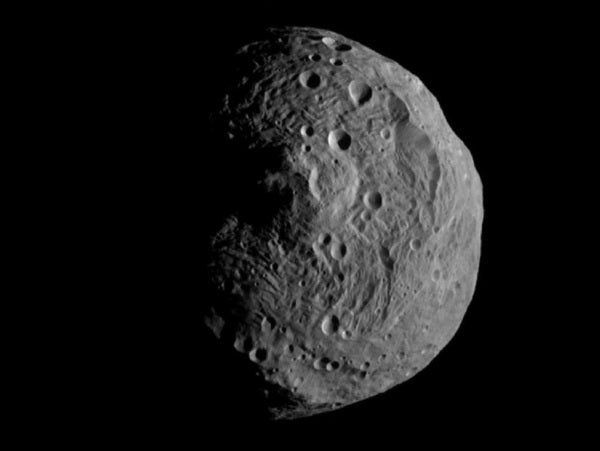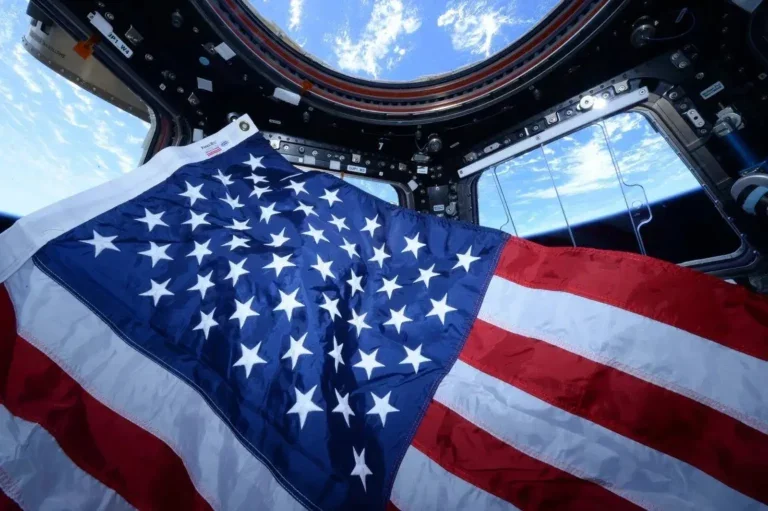The image taken for navigation purposes shows Vesta in greater detail than ever before. When Vesta captured Dawn into its orbit, there were approximately 9,900 miles (16,000 kilometers) between the spacecraft and asteroid. Engineers estimate the orbit capture took place at 1 a.m. EDT.
Vesta is 330 miles (530 km) in diameter and the second most massive object in the asteroid belt. Ground- and space-based telescopes have obtained images of Vesta for about two centuries, but they have not been able to see much detail on its surface. “We are beginning the study of arguably the oldest extant primordial surface in the solar system,” said Christopher Russell from the University of California, Los Angeles. “This region of space has been ignored for far too long. So far, the images received to date reveal a complex surface that seems to have preserved some of the earliest events in Vesta’s history, as well as logging the onslaught that Vesta has suffered in the intervening eons.”
Vesta is thought to be the source of a large number of meteorites that fall to Earth. Vesta and its new NASA neighbor are currently approximately 117 million miles (188 million km) away from Earth. The Dawn team will begin gathering science data in August. Observations will provide unprecedented data to help scientists understand the earliest chapter of our solar system. The data also will help pave the way for future human space missions.
After traveling nearly 4 years and 1.7 billion miles (2.8 billion km), Dawn also accomplished the largest propulsive acceleration of any spacecraft, with a change in velocity of more than 4.2 miles per second (6.7 km/s) due to its ion engines. The engines expel ions to create thrust and provide higher spacecraft speeds than any other technology currently available.
“Dawn slipped gently into orbit with the same grace it has displayed during its years of ion thrusting through interplanetary space,” said Marc Rayman from NASA’s Jet Propulsion Laboratory (JPL) in Pasadena, California. “It is fantastically exciting that we will begin providing humankind its first detailed views of one of the last unexplored worlds in the inner solar system.”
Although orbit capture is complete, the approach phase will continue for about 3 weeks. During approach, the Dawn team will continue a search for possible moons around the asteroid; obtain more images for navigation; observe Vesta’s physical properties; and obtain calibration data.
In addition, navigators will measure the strength of Vesta’s gravitational tug on the spacecraft to compute the asteroid’s mass with greater accuracy than has been previously available. That will allow them to refine the time of orbit insertion.
Dawn will spend 1 year orbiting Vesta, then travel to a second destination, the dwarf planet Ceres, arriving in February 2015.
The image taken for navigation purposes shows Vesta in greater detail than ever before. When Vesta captured Dawn into its orbit, there were approximately 9,900 miles (16,000 kilometers) between the spacecraft and asteroid. Engineers estimate the orbit capture took place at 1 a.m. EDT.
Vesta is 330 miles (530 km) in diameter and the second most massive object in the asteroid belt. Ground- and space-based telescopes have obtained images of Vesta for about two centuries, but they have not been able to see much detail on its surface. “We are beginning the study of arguably the oldest extant primordial surface in the solar system,” said Christopher Russell from the University of California, Los Angeles. “This region of space has been ignored for far too long. So far, the images received to date reveal a complex surface that seems to have preserved some of the earliest events in Vesta’s history, as well as logging the onslaught that Vesta has suffered in the intervening eons.”
Vesta is thought to be the source of a large number of meteorites that fall to Earth. Vesta and its new NASA neighbor are currently approximately 117 million miles (188 million km) away from Earth. The Dawn team will begin gathering science data in August. Observations will provide unprecedented data to help scientists understand the earliest chapter of our solar system. The data also will help pave the way for future human space missions.
After traveling nearly 4 years and 1.7 billion miles (2.8 billion km), Dawn also accomplished the largest propulsive acceleration of any spacecraft, with a change in velocity of more than 4.2 miles per second (6.7 km/s) due to its ion engines. The engines expel ions to create thrust and provide higher spacecraft speeds than any other technology currently available.
“Dawn slipped gently into orbit with the same grace it has displayed during its years of ion thrusting through interplanetary space,” said Marc Rayman from NASA’s Jet Propulsion Laboratory (JPL) in Pasadena, California. “It is fantastically exciting that we will begin providing humankind its first detailed views of one of the last unexplored worlds in the inner solar system.”
Although orbit capture is complete, the approach phase will continue for about 3 weeks. During approach, the Dawn team will continue a search for possible moons around the asteroid; obtain more images for navigation; observe Vesta’s physical properties; and obtain calibration data.
In addition, navigators will measure the strength of Vesta’s gravitational tug on the spacecraft to compute the asteroid’s mass with greater accuracy than has been previously available. That will allow them to refine the time of orbit insertion.
Dawn will spend 1 year orbiting Vesta, then travel to a second destination, the dwarf planet Ceres, arriving in February 2015.










